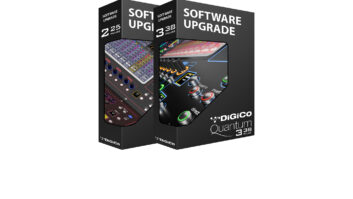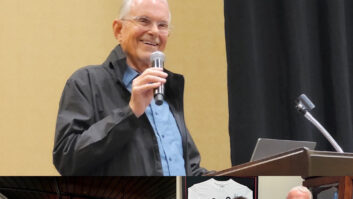The times are changing fast for entertainment hardware and software marketers thanks to the advances in digital technology and the Internet, and while new business models will have to be adopted, particularly in the software sales area, this isn’t yet the time to walk away from today’s formats.
That’s the key message delivered by speakers at seminars staged at the 30th annual Recording Media Forum recently staged in La Quinta, Calif. by the International Recording Media Association (IRMA, and formerly ITA).
Even DVD, while a smash hit in the U.S., still has a ways to go to make it in may overseas markets, according to Steve Nickerson, worldwide DVD marketing VP for Warner Home Video. He appeared at the IRMA event last year representing hardware in his role as Toshiba marketing VP.
While the U.S., with some five million DVD homes, is entering the second phase of the market, “certain markets aren’t really past Phase One yet,” he said, and pointed to Japan as “the poster boy for how to do it wrong.”
Sales in Japan have been so sluggish, he said, that the 900,000 PlayStation 2 game consoles Sony sold there last month effectively doubled the number of DVD players in use.
As for the U.S., Nickerson said, the market development has been held back somewhat by poor forecasting. “Forecasters relay on historical data,” and while this works for mature products, “it’s not working well for DVD.” He said no one was predicting 1999 would be a four-million set year, and the industry wasn’t ready for the fourth quarter sales surge.
Nickerson said that at the CES in January CEA issued a forecast calling for DVD sales this year of 6.5 million, but based that on the results of a member survey taken in October. A survey of the same group of companies taken by the DVD Entertainment Group in December produced a consensus forecast for sales of 8 million.
But in the real world, actual DVD player sales in the first two months of this year ran 200% ahead of 1999. While that won’t be sustained to produce a 12-million set year in 2000, Nickerson pointed out, growth for the remaining 10 months would have to drop to a 49% average for the year to come in at the CEA estimate. “What will we have to do wrong to get there?” he asked.
That DVD has emerged as a mainstream market item in the U.S. is without question, Nickerson said. He pointed out that 10% of home will have DVD players by the end of this year, “and there is no precedent for a product to get to 10% penetration and fail.” And there is plenty of opportunity for continued rapid growth beyond that, he pointed out. Helping to drive the market later this year, Nickerson said, will be 13″ and 19″ TV/DVD combos, more portable brands, carousel players and DVD drives for PCs. In the future, he said recorder DVD, DVD-Audio and cross platforms, such as PlayStations, will continue to fuel the market.
Warner, he said, is estimating the world market will absorb some 20 million DVD players this year, about half in the U.S., and some 500 million discs, against about 230 million in 1999.
Following his presentation, Nickerson told TWICE Warner is cautioning is software retailers against over reaction to the growth of DVD by cutting back on the space devoted to VHS titles. In most stores inventory is now 65% VHS and 35% DVD, and some are looking to reverse that. But, Nickerson said, it’s much too soon for that, and while the space given to DVD should be increased, dealers would do best by keeping VHS stocks at current levels and cutting back in other, slow moving areas such as audio cassettes.
The meeting’s tone was set by opening keynoter, futurist Bran Ferren, who is soon to leave his post as president of Disney Imagineering R&D and Creative Technology. Looking at the massive impact the Internet has already had, Ferren said “what we are seeing now are only the ripples before the tidal wave” of change that’s coming.
For information and entertainment, Ferren said, the Internet “provides the widest (audience) reach at the lowest cost,” and will cause “continuous change of product delivery and storage systems.” He said attempts to restrict the flow of material will fail, and survivors in the software industry will be those who adopt new revenue stream concepts.
A somewhat more comforting view of the immediate future was offered by Dick Kelly, president of the Cambridge Associates research firm. Looking at the coming of digital TV, he said it will be a good five to eight years before all the gee whiz effects, including video on demand and streaming Internet video, have any meaningful impact on the market for today’s blank and pre-recorded software formats.
He estimated that by 2006, at which time all analog TV broadcasting is supposed to end, only about 35% of U.S. home will be equipped for digital TV.
Even major digital TV proponents, Ted Malone of TiVo and Sidney Chen of Replay TV, marketers of personal video recorders, acknowledged their studies showed consumers want to be able to store TV programs they record on removable media. So even consumers who own PVRs will still have to make safe-keeping recordings in VCRs and upcoming DVD recorders.
In keeping with that concept, Maxell executive VP Don Patrican said the apparent fade away of the audio cassette doesn’t reflect a lack of consumer interest in audio recording. He said blank CD-Rs, which represented only about 1% of the audio recording market in 1998, will account for 50% by 2002 with volume of 150 million units, as sales of recording drives climb to 5 million from the 4 million of 2001 and the 3 million expected this year.
A more iffy prospect, however, seems to lie ahead for two other new digital audio formats, multi-channel DVD-Audio and the Sony-Philips backed stereo Super Audio CD.
Two members of the panel discussing the future of those formats, Lou Vaccarelli of BMG and Paul West of Universal Music, agreed that when two competing formats enter the market at the same time, one is bound to fail. They agreed that DVD-A, which their record companies are supporting, is the likely winner. Buy Malcolm Davidson of Sony Music, which also is a member of the DVD-A camp, said this isn’t “a zero sum gain.” Both can survive if dual-mode players are on the market, and with “many creative people in technology and in the market place,” the industry can select the best features of both and come up with one standard system.
A major point of agreement of all three was that only the so-called “golden ear” people among studio engineers and advanced audiophiles will be able to hear any real difference between DVD-A and standard CDs encoded with Dolby or DTS surround. The initial growth of the super-sound formats will rely on word of month support from early adopters. The average “consumer may not recognize difference, but once he starts playing it for a while he won’t be able to go back” to standard CDs, said Vaccarelli. Also, he added, the visual and interactive features of DVD-A will be a major sales booster. “I don’t think CD is going to cut it any more.”
While his two co-panelists were uncertain just how much software support a new audio format might need, West was much more definite. He said that by shortly after launch, there should be some 45 titles available in each of the major categories _ classic, rock, rap, etc _ so several hundred will have to be out. . “If the content that the consumer wants happens to be on this format, that’s what I’m going to buy and I don’t care about anything else,” West said.













